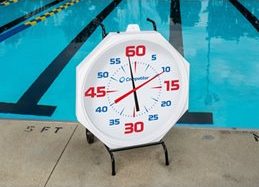The streamline position is one of the first things we are taught as a young swimmer. Nearly everyone, at some stage, had to do rocket ships of the end of the pool. So why is it some young swimmers still don’t do it every lap? There are a lot of reasons why really. As young swimmers develop the importance of the streamline skill cannot be overemphasized. With water being 800 times denser than air it’s crucial that coaches focus on this skill.
Save time with streamline.
As a Coach, you should be explaining the importance of corrrect streamline position to your swimmers as soon as possible. The sooner they understand why streamline is so important then sooner they will want to do it every single lap.  For example, if you are swimming a 100 freestyle short course event, then you are doing 3 freestyle turns. On top of this, you have a dive too. If a swimmers streamline correct and they combine this with a good fly kick they can potentially save half a second per lap. When a young swimmer is trying to make it to a major event this could be the second and a half that they are missing. Now, I’m sure that every young swimmer would love to save that much time for putting in that little effort.
For example, if you are swimming a 100 freestyle short course event, then you are doing 3 freestyle turns. On top of this, you have a dive too. If a swimmers streamline correct and they combine this with a good fly kick they can potentially save half a second per lap. When a young swimmer is trying to make it to a major event this could be the second and a half that they are missing. Now, I’m sure that every young swimmer would love to save that much time for putting in that little effort.
So what’s the best way?
The difference between doing a correct or incorrect streamline could make or break your race. Whilst in the streamline position you have to be sure to have your hands overlapped. The grooves of one hand are filled by the finger pads of the other so that both hands are in alignment. Your hands should be locked by the upper hand’s thumb. It should wrap around the edge of the lower hand. Make sure your arms are pointing straight above your head. Your biceps should be squeezing the ears as your head is in a neutral position. There is a lot of controversy in the swimming community as to which streamline is better. Another method for streamline is to have your biceps behind the ears. However, this is an argument for another day.
Your arms and upper body should be held tight. Then you need to stretching as far out or up as they can. You should feel the stretch in their rib cage area. It is important that you keep the trunk of their body shoulders and arms all in alignment. Any form of slouching or shrugging will decrease your efficiency in the water. Your head should be in a neutral position and eyes point down towards the bottom of the pool. Your legs should be tight together and with the inside of the thighs, calves and feet. As well as pointing your toes to maintain a nice streamline position.
Streamline drilling
A great deal to practice is where you push or dive and hold to streamline position for as long as you can, without kicking. While doing this you should think about how the water moves around your body and how it feels as you speed through the water. You can make it a competition but be sure you do not kick, twist or move in any way. If you work hard at this drill you not only learn a good streamline position but also how to  engage your core to maintain that nice tight flat streamline. This drill can later be combined with breakouts and fly kicks. But for now, it is important to just focus on the basics.
engage your core to maintain that nice tight flat streamline. This drill can later be combined with breakouts and fly kicks. But for now, it is important to just focus on the basics.
The distance that you should take streamlining depends on your coach and your opinion. But as a general rule of thumb with a push and glide streamline you can make the five-metre mark in most cases.
What can Coaches do to develop a streamline culture?
One of the best things you as a coach can do is to develop a culture of commitment towards streamline. You can talk about this at team meetings as well as reinforce this on the pool deck. Working this into your warm-up you can encourage your swimmers to do streamline every turn every time without fail. Coaches can also go to extreme measures to enforce this skill. For example, if every swimmer does not do streamline every lap, then the whole lane has to start that said again. Although extreme this method really does underline how important streamline is to the swimmers participating. Always remember Gold is in the details…